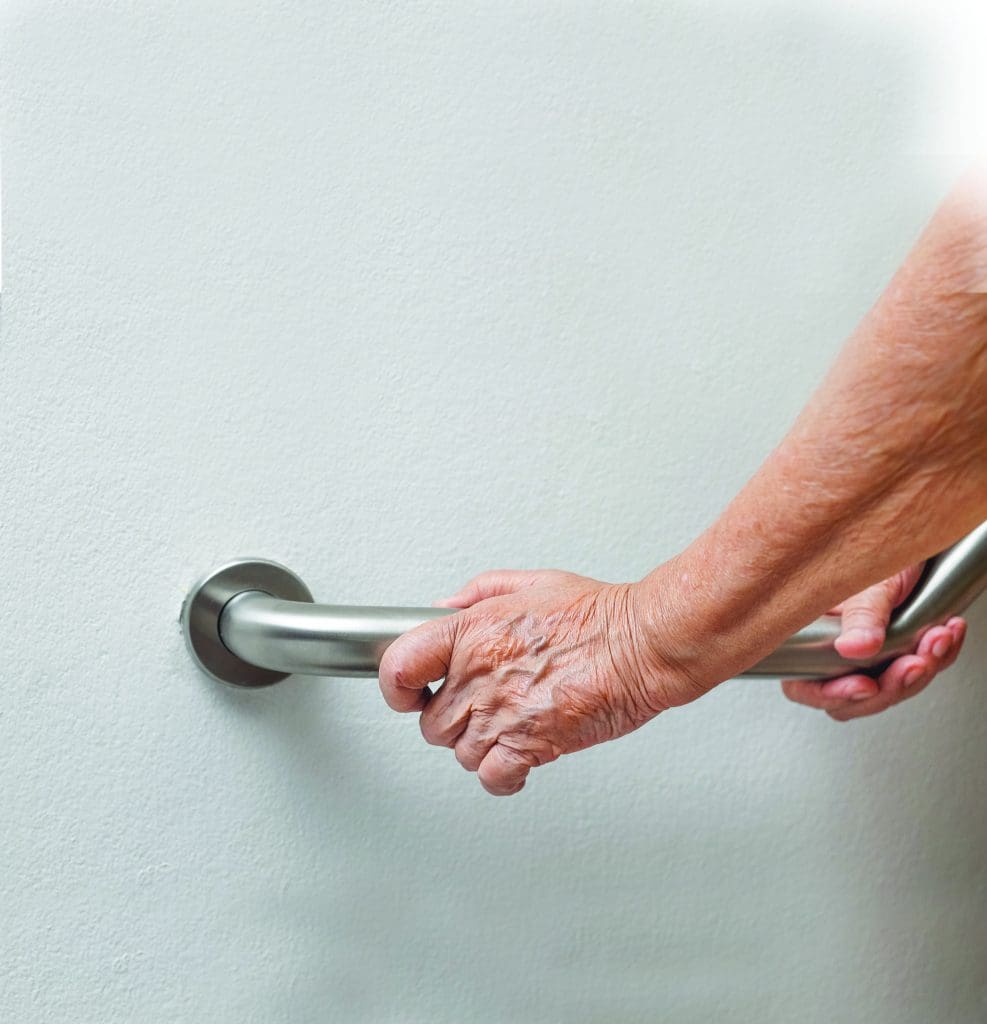Put the focus on prevention.
- The burden of older adult falls is overwhelming EMS and Emergency Departments with over 70% requiring transport into hospital EDs due to urgent or emergent healthcare needs, this burden only projected to increase with the aging of the US population. From the point of patients’ entry into ERs, nurses rely on their expertise as they triage and assess patients who present with a fall, referred to as a Known Faller, as a primary diagnosis or secondary due to a medical condition, providing critical information about initial fall and injury risk factors.
- Using case study examples, a clinical opportunity exists to elevate the importance of ED nurses’ clinical judgement and interventions to protect patients falling from stretchers, toilets, while ambulating, through individual fall prevention care plans, patient education, and redesigned safe care environments. Integration of surveillance and sensor technology at the point of care complements nursing staff’s goal for assisted mobility, eliminating unassisted stretcher and toilet exits.
- Describe the use of screening vs. assessment tools used to evaluate fall risk.
- Identify key tools developed to assess home safety fall prevention.
- Explain components of a fall prevention plan for a known faller admitted through the emergency department.
No relevant financial relationships were identified for any individuals with the ability to control content of the activity.
Expiration: 6/1/27
Patients who arrive in the emergency department (ED) because of a fall or with a medical condition or after an accident that resulted in a fall, require prevention and protective measures. For these patients (known fallers), we need to ask the question, “Why did the patient fall?” not “Is the patient at risk for a fall?”
The VIP treatment: A comprehensive post-fall assessment guideline
The Bedside Mobility Assessment Tool 2.0
Key ED components—including triage and a focus on the acutely ill or injured patient, along with disease or injury identification, diagnosis, observation, and monitoring—provide the framework for EDs to re-engineer fall prevention programs. All of these are especially relevant for older adults who arrive after a fall because this population faces the greatest risk for repeat falls and fall-related injuries. Knowledge and expertise can help determine why each patient fell and why they might be at risk for falling again. For example, we know the core fall risk factors for patients diagnosed with right-brain vs. left-brain stroke, hip fractures, chronic heart failure (CHF), and chronic low back pain. Then, with intention, the clinical team can take steps to protect the known faller from falling again. This requires screening, and if positive, assessment of individualized fall risk factors, along with injury risk and history. (See Screening and assessment tools.)
Screening and assessment tools
Nurses should use fall risk assessment tools validated for the appropriate population, such as emergency, acute, maternity, and community dwelling populations. Emergency departments (EDs) have access to validated fall risk screening and assessment. However, only a few screening tools exist specifically for use in the ED. They include the following:
- Australia’s FROP-Com (Fall Risk for Older People in Community) Screening Tool for EDs includes questions about falls history in the last year.
- Tiedemann screening tool for EDs asks two questions: Have you had two or more falls in the past 12 months (same as the timeframe for annual screening for geriatric outpatients)? Are you taking six or more medications?
- eHDS (emergency Hester Davis Scale) screening tool for fall risk, mobility, and behavior doesn’t include questions about fall history.
No matter which screening tool you use, positive screens require a fall risk assessment, such as one of the following:
- Memorial ED Fall Risk Assessment Tool asks about history of falls in the past 3 months.
- Kinder1 Fall Risk Assessment Tool asks about falls in the past year (the same timeframe as annual screenings for geriatric outpatients) and offers direct interventions for those who present to the ED due to a fall.
Screening and assessment tools produce a score as the basis for risk level, which nurses can use to establish universal fall prevention interventions.
Screening enables clinicians to produce an evolving individual fall prevention care plan with aligned interventions aimed at mitigating and eliminating fall risk factors. In hospitals, this process begins in EDs, where nurses use their clinical expertise and management to prevent falls.
Fall burden in EDs and hospitals
The Centers for Disease Control and Prevention (CDC) provides national data on causes of unintentional injury, related hospitalizations, morbidity, and mortality reported by age group. Older adults are at greatest risk for loss of function or loss of life if they fall. Each year, millions of older adults ≥65 years of age fall. In 2018, the CDC estimated that one out of four older adults (28%) fell, resulting in 36 million falls. However, less than half of older adults who fall tell their doctor. Many rely on emergency medical services (EMS) for rescue and recovery after a fall, but they won’t require transportation to the ED. The burden of older adult falls on EMS and EDs is expected to increase.
As reported by Vastis, falls among older adults have surpassed fire victims in required EMS responses, accounting for 17% of 911 calls. Of calls to EMS for rescue and recovery from a fall, 79% require transport to an ED. Many falls occur because of an urgent, emergent medical event such as syncope, orthostasis, CHF, sepsis, or urinary tract infection; others occur as a result of accident or trauma.
The National Council on Aging (NCOA) notes that every 11 seconds, an older person visits the ED due to a fall. In 2018, according to Eckstrom and colleagues, of 8 million falls with injury, 3 million (37.5%) older adults presented to the ED for urgent or emergent care. Over 800,000 patients are hospitalized each year due to fall injury, most frequently a head injury or hip fracture. According to the CDC, many older adults are discharged to their primary residence. Hospital admissions occur primarily in the event of injury or need for medical evaluation.
For almost every older adult who enters the ED as a result of a fall, the healthcare team prioritizes treating any injury. After that, the team turns to medical evaluation, treatment, and stabilization. The fall care plan begins based on type and cause of injury, followed by screening for fall risk. The exception exists for patients who present due to a fall. These patients should be treated based on fall etiology and then assessed for other fall risk factors.
Case studies
The literature frequently discusses screening and assessment tools inaccurately. For example, Strini and colleagues classify the Morse Fall Scale (MFS) as an assessment tool when it’s actually a screening tool that requires an assessment in the event of a positive result. Morse asserted 30 years ago that nurses should use their clinical judgement, irrespective of the MFS score. Oliver and colleagues also concluded that nurses’ clinical judgement was just as effective in determining patients’ risk for falls when compared to two acute care fall risk tools: MFS and St. Thomas’s Risk Assessment Tool in Falling Elderly Inpatients (STRATIFY).
ED nurses must be allowed to use their clinical expertise to address fall etiology based on the patient’s urgent, emergent presentation, as presented in the following case studies.
Known faller discharged home
Ms. Donna Hart* arrives at the ED with increasing shortness of breath over the past 2 days and wheezing the previous night. Ms. Hart, who lives with her daughter and son-in-law in a two-story home, has a history of CHF; she’s 82 years old, 5’3″, and weighs 158 lbs. Your triage and assessment indicate CHF exacerbation. Auscultation reveals diminished breath sounds in the bilateral lower lung. You note bilateral 1+ pitting edema of the patient’s lower extremities.
On arrival in the ED, Ms. Hart’s oxygen saturation level is 82%. After receiving 2L of oxygen via nasal cannula, her saturation level increases to 98%. The ED provider prescribes furosemide 40 mg to relieve the edema.
While in the ED, Ms. Hart’s daughter reports that her mother fell from the bed onto the carpet the night before admission. The family helped her up from the floor and to the bathroom. She had no difficulty walking. The daughter also reports that her mother has mild memory deficits, and that she received a diagnosis of new onset dementia within the past 6 months. Ms. Hart lives on the first floor of the home in a carpeted bedroom with an attached bathroom equipped with a raised toilet seat and bilateral grab bars. Family members supervise her daily activities and offer assistance as needed.
Ms. Hart’s only medications are digoxin 0.125 mg/day for prior arterial fibrillation and one multivitamin and one vitamin D supplement daily.
At discharge, Ms. Hart receives prescriptions for oxygen and furosemide 20 mg/day. The provider orders home health services for physical therapy (PT) and occupational therapy (OT) evaluation, treatment, and an at-home exercise program. The provider also orders a bedside commode and prescribes a toileting/hydration schedule to reduce fluids after 7:00 pm to decrease nocturia. The home has one step without a rail at the front door. Healthcare and patient safety planning can help reduce the chances that Ms. Hart will fall again.
Takeaways. As described in this case study, once a patient has stabilized and is ready for discharge, clinicians can take the opportunity to address the chief complaint and general fall prevention measures, including resources for medical follow-up and schedules, medications, and other consults.
All older adults have fall risk factors, some modifiable and some not (age, gender, race/ethnicity, history of falls). To address modifiable fall risk factors, invite conversations to discuss fall prevention when older adults and families or caregivers are most receptive. Discuss home safety and provide, without exception, the CDC’s STEADI (STopping Elderly Accidents Deaths and Injuries) home safety checklist (cdc.gov/steadi/pdf/steadi-brochure-checkforsafety-508.pdf). If the patient takes any medications with the potential for postural hypotension, provide the patient with CDC STEADI education on the topic (cdc.gov/steadi/pdf/steadi-brochure-postural-hypotension-508.pdf).
Remind all older adults to use their assistive devices, take steps to ensure proper nutrition and hydration, and follow measures to reduce risk of nocturia. Referral to PT and OT as needed or a community home exercise program can help address balance issues. For older adults with cognition, memory, or other safety deficits, discuss plans for surveillance and supervision at home.
If your ED places follow-up phone calls to review patient satisfaction with services, ask patients if they’ve experienced a fall since discharge or have any concerns about falling. If they have, advise them to contact their primary care provider.
Known faller admitted
Mr. Larry Johnson (87 years old, 5’9″, 175 lbs) injures his back when he falls while trying to stand from his recliner. He lands on his buttocks onto the carpet with his legs extended. Because he can’t get up, he uses Life-Alert to activate EMS. When EMS personnel arrive, they find Mr. Johnson coughing, wheezing, showing signs of shortness of breath, and unable to get up from the floor. His vital signs are oxygen saturation 78%, heart rate 106 beats per minute, and respirations 24 breaths per minute. Mr. Johnson says that he feels dizzy. EMS starts him on oxygen at 4 L/min.
Mr. Johnson tells EMS that he has no hip or leg pain; he can feel and move his legs and feet. EMS assists him to a standing position and then onto a stretcher for transport to the ED. During transport, EMS takes a medical history, which includes type 2 diabetes, myocardial infarction, CHF, prior left hip fracture (he wears hip protectors), osteoporosis, and peripheral neuropathy. His medications include metformin, furosemide, alendronic acid, enoxaparin, and gabapentin.
Upon arrival in the ED, the clinical team begins work to determine the etiology of Mr. Johnson’s fall (they ask the patient and EMS if he experienced balance loss, a slip or trip, dizziness, hypoglycemia, or increased difficulty breathing). The ED team also asks if the patient was in an urgent or emergent state when EMS arrived and about any treatment administered. In addition, the team evaluates Mr. Johnson for any other risk factors that require ED admission and further workup. For example, if Mr. Johnson fell as a result of dizziness, the healthcare team will evaluate him for postural hypotension. If he fell because of difficulty breathing, they’ll order a chest x-ray.
During this initial workup, the team also screens Mr. Johnson for other fall risk factors, including history of previous falls, medications that contribute to fall risks, mental status, balance, and nocturia. They learn about Mr. Johnson’s history of osteoporosis and left hip fracture. He now uses a cane.
The ED provider diagnoses Mr. Johnson with mild bilateral pleural effusion, CHF, postural hypotension, and peripheral neuropathy. Laurel, the ED nurse, assesses Mr. Johnson as high risk for fall as a result of his fall history, secondary diagnoses, use of a mobility aid, and indications that he may overestimate his abilities. She anticipates that Mr. Johnson may not call for help before trying to get up from the stretcher.
Laurel initiates an individualized fall prevention and clinical management care plan for Mr. Johnson. (See Mr. Johnson’s fall prevention plan.)
Mr. Johnson’s fall prevention plan
Based on Mr. Johnson’s medical history, Laurel, the emergency department nurse, develops the following individualized fall prevention and clinical management care plan:
- Coughing/shortness of breath. Administer oxygen as ordered and monitor patient response.
- Postural hypotension (PH). Complete evaluation with 2 person assist and use a gait belt in case of onset of decreasing blood pressure (BP). Evaluate severity of PH by assessing BP and pulse after lying for 5 minutes, immediately upon standing, or within 1 minute and at 3 minutes after standing. If BP drop occurs, assess for compensatory elevation of pulse.
- Peripheral neuropathy in lower extremities: Apply socks and shoes for all transfers and ambulation. Do not apply nonskid socks (they increase fall risks in those with peripheral neuropathy).
- Ambulation deficits (weakness/use of cane for ambulation). Ambulate Mr. Johnson using contact guard assist and a gait belt. Because he walks with a cane, ensure he uses it; if it isn’t present, obtain a two-wheeled walker for use during ambulation. If no ambulatory device is available, avoid ambulation until physical therapy evaluates Mr. Johnson. Physical therapy evaluation with necessary treatment and assistive devices will aid development of a safety plan at discharge.
- Overestimates abilities. Apply a stretcher positioning alarm at shoulder level to alert nursing staff when Mr. Johnson moves toward a sitting position to ensure he receives assistance.
- Assisted elimination. Help Mr. Johnson with all elimination and provide a urinal/bedside commode. Don’t take him to the ED bathroom.
The prevention plan also addresses Mr. Johnson’s risk for fall-related fracture. It includes placing a floor mat next to the stretcher and continued use of physician-ordered hip protectors.
As a result of difficulty breathing, Mr. Johnson is approved for admission to the hospital for evaluation and management. Laurel communicates the plan of care along with other clinically relevant information to the admitting RN. In addition to fall prevention, her hand-off includes reducing injury risk (due to the previous hip fracture) if Mr. Johnson falls.
During Mr. Johnson’s stay in the hospital’s medical unit he requires assistance with activities of daily living (ADLs) and moderate assistance with bed mobility (transfers and ambulation) due to back pain, shortness of breath, and pain medications. To continue to create and maintain a safe environment, the healthcare team places “Known Faller” (rather than “High Fall Risk”) signage in Mr. Johnson’s room because of his fall at home, high fall risk, and risk for injury.
Inpatient assessment confirms that Mr. Johnson is cognitively alert X2 (person and place) and requires minimal assistance with bathing and personal hygiene. The furosemide prescription requires assisted toileting at least every 2 hours after administration and then every 2 hours during day and evening shifts. To prevent Mr. Johnson from getting out of bed unassisted, a bed positioning alarm alerts nursing staff when he moves. The medical nurse continues all prior fall and injury prevention interventions initiated in the ED.
Takeaways. Injury interventions should always be patient specific, not setting specific. Determination of risk factors must drive interventions to mitigate or eliminate fall risk from the ED to admission and throughout a patient’s hospital stay.
Create a safe ED environment
A safe environment supports accidental falls prevention and maximizes safe patient interaction within the ED. Examples of environmental fall risks include stretcher placement and height, low toilets, insufficient toilet grab bars, lack of bedside commodes, and limited visual access for surveillance. This knowledge requires taking action to increase safety via telesitter technology, sensors that monitor patient movement and alert nurses, and bathroom assistive devices (raised toilet seats, bedside commodes, and bilateral safety rails).
Safe transfer mobility integration into ED fall prevention programs requires focused attention to fall prevention from stretchers, safe exit sides, and using contact guard/stand-pivot transfers toward the strongest side of a patient’s body.
Movement sensor technology exists for stretchers and bathrooms but many hospitals don’t use them. When positioned on a stretcher under a patient’s shoulders, these sensors detect movement associated with turning and lifting the body to a sitting position. To avoid alarming the patient, this technology activates through the nurse call system (wireless or wired) with the patient and location, which eliminates searching for the alert origin.
Sensor technology mounted behind a toilet, placed on a shelf, or positioned at bathroom doorways notifies ED staff when a patient enters a bathroom. Sensors placed on the wall behind a toilet alert staff when a patient starts to get up from a toilet without assistance. Similar to stretcher movement sensors, bathroom sensors connect to the nurse call system. The nurse knows the exact alarm location, which helps to ensure a fast response.
Falls in bathrooms can result in serious injury given the hard surfaces and sharp corners. The safest bathroom environments include raised toilet seats, folding grab bars on both sides of the toilet, and easy access to toilet paper. Standard Americans with Disabilities Act toilets must be 17″ to 19″ high (from floor to bowl rim); higher is always safer than lower. Folding grab bars on each side of the toilet allow for standing pivot transfers with assistance of a caregiver. Grab bars that can be lowered allow patients to grasp them during sit-to-stand and stand-to-sit as well as provide balance while seated.
Additional bathroom safety measures include eliminating sharp edges, replacing metal with PVC materials to reduce trauma, and placing trauma-absorptive flooring. Most EDs have one or two bathrooms commonly used by patients. However, staff should make bedside commodes available for patients who can’t safely use the bathroom based on evaluation of medical stability, cognition, mobility, and safety awareness.
Ongoing patient education
Patients don’t have the same perceptions of the risks and dangers of falls in hospitals as nurses do. Studies validate the disparity between patients’ risk perceptions (their beliefs and fears, receptivity to assistance, and perceived risk) and their physiological fall risk (chronic conditions, medications, actual fall risk factors, and risk level). From the point of entry and throughout all healthcare encounters, patients should receive ongoing education about falls and injury prevention. No matter a patient’s ultimate destination (hospital admission, home, or post acute care), ED nurses’ assessments, fall prevention care plans, communication with other healthcare teams, and patient education can prove critical to preserving patient autonomy, function, independence, and safety throughout care transitions.
*Names are fictional.
Patricia Quigley works as a nurse consultant out of St. Petersburg, Florida.
American Nurse Journal. 2024; 19(6). Doi: 10.51256/ANJ062406
References
Alexander D, Kinsley TL, Waszinksi, C. Journey to a safe environment: Fall prevention in an emergency department at a level I trauma center. J Emerg Nurs. 2013;39(4):346-52. doi:10.1016/j.jen.2012.11.003
Australian Commission on Safety and Quality in Healthcare. Guidebook for Preventing Falls and Harm from Falls in Older People: Australian Hospitals. 2009. safetyandquality.gov.au/sites/default/files/migrated/30459-HOSP-Guidebook1.pdf
Centers for Disease Control and Prevention. Facts about falls. May 12, 2023. bit.ly/3UaKpQy
Dabkowski E, Cooper S, Duncan JR, Missen K. Adult inpatients’ perceptions of their fall risk: A scoping review. Healthcare. 2022;10(6):995. doi:10.3390/healthcare10060995
Dolan H, Slebodnik M, Taylor-Piliae R. Older adults’ perceptions of their fall risk in the hospital: An integrated review. J Clin Nurs. 2022;31(17-18):2418-36. doi:10.1111/jocn.16125
Eckstrom E, Parker EM, Shakya I, Lee R. Coordinated care plan to prevent older adult falls. Centers for Disease Control and Prevention. 2021. cdc.gov/steadi/pdf/Steadi-Coordinated-Care-Plan.pdf
Flarity K, Pate T, Finch H. Development and implementation of the Memorial Emergency Department Fall Risk Assessment Tool. Adv Emerg Nurs J. 2013; 35(1):57-66. doi:10.1097/TME.0b013e31827c6a54
Kelekar U, Das Gupta D, Shepard JG, Sule AA. Risk factors of fall-related emergency department visits by fall location of older adults in the US. West J Emerg Med. 2021; 22(4):988-99. doi:10.5811/westjem.2021.2.49307
Kientz S, Hester A. Predictive model development and validation of the Emergency Hester Davis Scale© for fall risk screening. Nurs Res Rev. 2020;10:1-7. doi:10.2147/NRR.S247464
Krauss MJ, Nguyen SL, Dunagan WC, et al. Circumstances of patient falls and injuries in 9 hospitals in a midwestern healthcare system. Infect Control Hosp Epidemiol. 2007; 28(5):544–50. doi:10.1086/513725
Minnesota Hospital Association. Creating a safe environment to prevent toileting-related falls. December 8, 2014. bit.ly/3xxsI4K
Moreland B, Lee R. Emergency department visits and hospitalizations for selected nonfatal injuries among adults aged ≥65 – United States, 2018. MMWR Morb Mortal Wkly Rep. 2021;70(18):661-6. doi:10.15585/mmwr.mm7018a1
Morse JM. Preventing Patient Falls. Thousand Oaks, CA: Sage Publications; 1997.
Oliver D, Healey F, Haines TP. Preventing falls and fall-related injuries in hospitals. Clin Geriatr Med. 2010;26(4):645-92. doi:10.1016/j.cger.2010.06.005
Patel J. Heart failure population health considerations. Am J Manag Care. 2021;27(suppl 9):S191-5. doi:10.37765/ajmc.2021.88673
Rhew DC, Upham J. Decreasing falls in the emergency department by implementing use of voice activated stretcher alarm pads. JOJ Nurs HealthC. 2019;10(2):555785. doi: 10.19080/JOJNHC.2019.10.555785
Solie CJ, Swanson MB, Harland K, Blum C, Kin K, Mohr N. Two-item fall screening tool identifies older adults at increased risk of falling after emergency department visit. West J Emerg Med.2020;21(5):1275-82. doi:10.5811/westjem.2020.5.46991
Stevens JA, Ballesteros MF, Mack KA, Rudd RA, DeCaro E, Adler G. Gender differences in seeking care for falls in the aged Medicare population. Am J Prev Med. 2012;43(1): 59-62. doi:10.1016/j.amepre.2012.03.008
Strini V, Schiavolin R, Prendin A. Fall risk assessment scales: A systematic literature review. Nurs Rep. 2021;11(2):430-43. doi:10.3390/nursrep11020041
Tiedemann A, Sherrington C, Orr T, et al. Identifying older people at high risk of future falls: Development and validation of a screening tool for use in emergency departments. Emerg Med J. 2013;30:918-22.
Vastis A. Partnering with fire and emergency medical services to prevent falls. National Council on Aging. January 3, 2022. ncoa.org/article/partnering-with-fire-and-emergency-medical-services-to-prevent-falls
Venema DM, Skinner AM, Nailon R, Conley D, High R, Jones KJ. Patient and system factors associated with unassisted and injurious falls: An observational study. BMC Geriatr. 2019;9(1):348. doi:10.1186/s12877-019-1368-8
Key words: emergency department safety, patient safety, falls, falls prevention



















6 Comments. Leave new
It gave me a lot to think about about risk fall
informative article, however, the article fails to mention non-compliant patients ( to include dementia patients because they are cognitively impaired, or even known fallers). Time after time, we get patients who are resistant to hospital policy, education, bed alarms, and subsequently end up falling. We even have family members who are resistant to education. What should a nurse do then? Current studies even suggest that most nurses don’t ambulate patients because of their risk for falls. Subsequently, patients who need the most ambulation, don’t get it.
Thank you so much for your comments. Viewing patients who are cognitively alert as “resistant” lead to labeling them as Non-compliant means they are not following our rules. Healthcare is not about following rules, but rather partnerships. I removed non-compliance from my language years and years ago, because the ethical principle that I hold most dear in my relationships with patients, caregivers, family and friends is Autonomry. That’s the wrong pathway to patient partnership. Rather, we have to get to why a patient or family is choosing not to do something we think and recommend for them to do for their health, safety, etc. That takes us to teach-back – understanding the why of a choice that you think is “wrong” for someone else – for decisions – yes (compliant) or no (non-compliant). We are not rule-based healthcare… we have to change that mindset. I had this very conversations with nurses yesterday during a hospital visit. I encourage you and all who are interested to read my 2016 article on this very subject: Quigley, P. (2016). Autonomy and the patient’s right to choose falls prevention. The American Nurse Today, 11 (12). I look forward to your thoughts.
Thanks.. Pat
Excellent learning experience. Thank you for posting it.
This was an excellent class. All information was very timely & so useful. Learned some new ideas & what to look for in assessments. Thank you for posting this informational class.
Thank you again JoAnne! I am glad this information was helpful to you. If I can help you more, please let me know. You can contact me at pquigley1@tampabay.rr.com
All my best, Pat